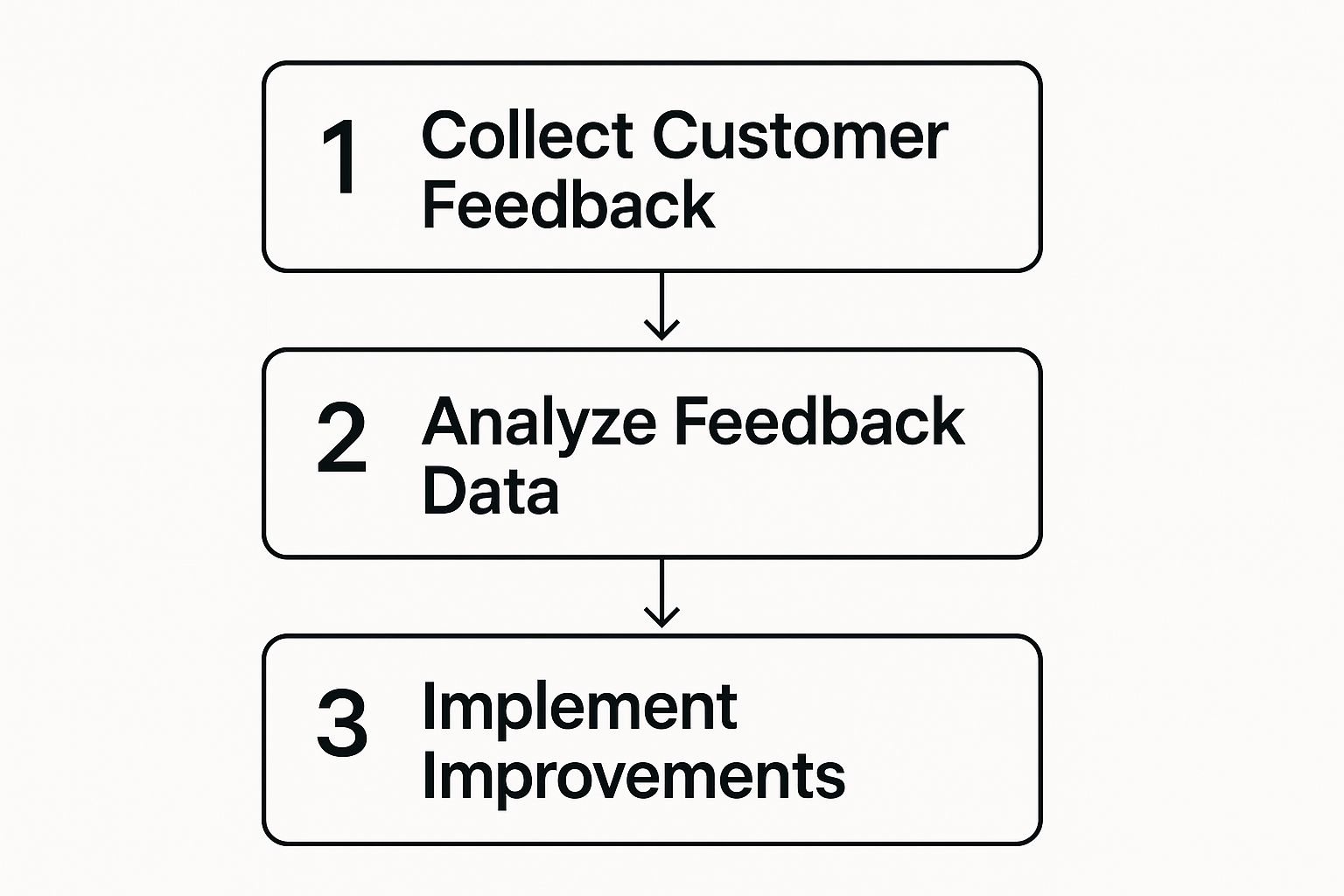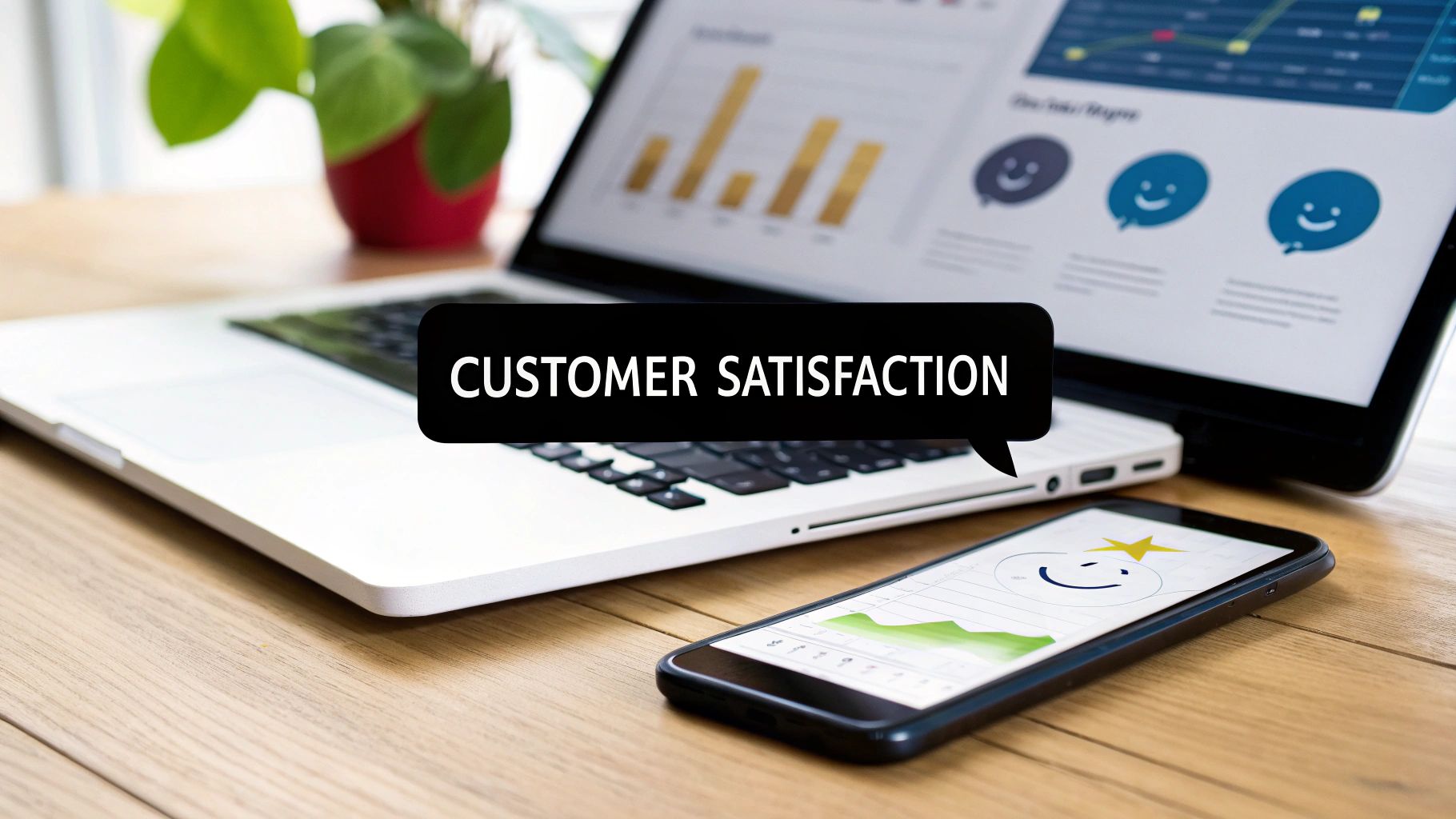Feeling the pressure to keep customers happy? You're not alone. In today's crowded e-commerce space, a great product isn't enough. The real battle is won in the experience you provide. If you're trying to figure out how to improve customer satisfaction, the answer is simpler than you think. It's about proactive, personal, and genuinely helpful communication where your customers already are—WhatsApp.
From our experience with over 500 Shopify stores, the brands that win are the ones who turn routine touchpoints into memorable conversations. This is how you build trust, earn loyalty, and stop competing on price alone. In this guide, you'll learn exactly how to implement practical strategies that boost satisfaction and drive repeat purchases.
Why Customer Satisfaction Is Your Most Valuable Metric
Let’s be direct. In e-commerce, customer satisfaction isn't a "nice-to-have" metric; it's a financial driver that directly impacts your brand's survival. Price and product are table stakes. After working with hundreds of brands, we've seen an undeniable pattern: higher satisfaction scores directly correlate with a higher Customer Lifetime Value (LTV), which is the total revenue you can expect from a single customer account.
A happy customer does more than just buy again. They become your most powerful and cost-effective marketing channel. For brands running on tight margins, this is everything. It's far more sustainable to delight your current customers than to constantly pay for new ones.
The Pillars of E-Commerce Customer Satisfaction
This table breaks down the core areas that directly influence how customers see your brand. From our experience, nailing these five pillars is non-negotiable for building a loyal following.
Focusing on these five pillars creates a holistic experience that makes customers feel confident and cared for every step of the way.

The Real Cost of a Poor Experience
Letting customer satisfaction slide isn't an option—it comes with a hefty price tag. A single bad experience is often enough to send a customer straight to your competition. The real challenge is that customer expectations are constantly climbing.
This gap between expectation and reality is your golden opportunity. A recent Forrester report revealed a troubling trend: experience quality is dropping across the board. In fact, 25% of North American brands saw their rankings fall. By simply delivering a consistently great experience, you're already ahead of the curve.
Connecting Satisfaction to Growth
When we talk about making customers happy, we're really talking about building loyalty and driving revenue. A truly satisfied customer is far more likely to:
- Buy again and again: This is what pumps up their LTV, a critical number for sustainable growth.
- Leave glowing reviews: Nothing sells your product better than authentic social proof.
- Give you a second chance: A history of good experiences creates a buffer when you inevitably make a mistake.
- Spend more with each order: Trust makes people comfortable buying more from you, which boosts your Average Order Value (AOV).
Think of every customer interaction as a deposit into a "satisfaction bank account." That proactive shipping update? Deposit. A quick, painless fix to a problem? Huge deposit. The bigger that balance gets, the healthier your business becomes. To get a real grip on this, you need to understand the numbers. Our guide on how to calculate customer lifetime value is the perfect place to start.
Win Customers with Proactive Conversational Support
The old model of customer support is broken. If you're just waiting for an angry customer to email you, you've already lost. That reactive approach erodes trust and costs you more in the long run.
The strategy that consistently delivers the best results for our clients is proactive, conversational support. It's all about getting ahead of problems before your customer even knows there’s an issue.
For example, a small shipping delay occurs. Instead of waiting for the inevitable "Where is my order?" ticket, you send a friendly WhatsApp message. Suddenly, a potential complaint becomes a trust-building moment. You're showing them you care about their entire experience, not just the sale.
The Power of Being Proactive
From our experience with over 500 Shopify stores, the number one source of customer anxiety is the uncertainty after they click "buy." Sending proactive updates on WhatsApp hits this problem head-on.
Why WhatsApp? It boasts an incredible 98% open rate. Your message is almost guaranteed to be seen, unlike an email drowning in a sea of promotions.
Shifting from reactive to proactive support does more than just make customers happier—it slashes your support ticket volume. We've seen clients cut down their "Where is my order?" questions by over 60% just by setting up simple, automated shipping alerts.
Setting Up Your Proactive WhatsApp Flows
Getting this running is easier than you think. As an official Meta Business Partner, Kanal lets you create automated message flows that trigger directly from your Shopify store's activity.
Here are the three must-have flows you should set up today:
- Order Confirmation: The second someone makes a purchase, send a confirmation for instant peace of mind.
- Shipping Notification: As soon as you fulfill the order, automatically send a message with the tracking link.
- Delivery Update: A quick note to say "It's arrived!" This closes the loop and is the ideal time to ask for feedback.
Crafting Messages That Actually Sound Human
Just because it's automated doesn't mean it has to sound robotic.
Here's an order confirmation template that works:
"Hey [Customer Name]! 👋 Your order #[Order Number] is confirmed! We're already getting it ready for you. We'll ping you again as soon as it ships. Thanks for shopping with [Your Brand Name]! ✨"
And what to say if there's a small delay:
"Hi [Customer Name], a quick heads-up from [Your Brand Name]. It looks like your order #[Order Number] is running a little behind schedule. We're on it and expect it to ship within 24 hours. We're so sorry for the delay and really appreciate your patience!"
Putting these proactive systems in place creates a powerful feedback loop that helps you get better over time.

As you can see, the process is circular: collecting feedback leads directly to implementing improvements, which then boosts the customer experience. When you nail proactive communication, you're building a solid foundation for stronger customer relationships—a core idea we explore in our guide on how to increase customer engagement.
Build Real Trust with Personalized Messaging
Let's be honest: generic marketing blasts are dead. If you're serious about figuring out how to improve customer satisfaction, you have to stop treating customers like order numbers. True personalization is more than just sticking a {{first_name}} tag in an email.
It's about using the data you already have—like what they've bought—to send a message that feels written just for them. This is how you become a trusted advisor.

Go Deeper Than Demographics with Smart Segmentation
A common mistake we see is sending the same campaign to an entire list. The key is to slice your audience into meaningful groups based on what they do.
Using a tool like Kanal, you can pull directly from your Shopify data to create these super-specific segments. Here are a few high-impact groups to build first:
- Your VIPs: These are customers who have spent over a certain amount (say, $500) or have purchased multiple times. Treat them like gold with early access or surprise offers.
- The Newcomers: Create a welcome series that introduces them to your brand. A week after their order arrives, send a helpful tip on how to use their new purchase.
- Product-Specific Buyers: Group customers based on what they bought. If someone bought a particular skincare product, follow up with a personalized guide for their routine.
Creating segments like this lets you send messages that actually land.
Putting Personalization to Work: A Real-World Example
Here's a real-world example from a brand we work with. A beauty brand had amazing products but a low repeat purchase rate. Customers loved what they bought but had no compelling reason to return.
The strategy that consistently delivers the best results for our clients is... using past purchase data to provide genuine value. You're not just pushing for the next sale; you're helping them succeed with the last one.
We set up a simple automated flow. If a customer bought their best-selling "Hydrating Face Serum," two weeks later they’d get a WhatsApp message with a short guide titled, "3 Ways to Layer Your New Serum for Maximum Glow." No hard sell, just pure value.
The result? Their repeat purchase rate shot up by 22% in just three months. They became a partner in their customers' skincare journey. That's how you build a bond competitors can't break. You can dive deeper into the role of trust in customer satisfaction here.
Build a Feedback Loop That Actually Sparks Change
It’s one thing to ask for feedback. It’s another to do something with what they tell you. Honestly, that last part is where most e-commerce brands stumble. To truly boost customer satisfaction, you need a system that does more than just gather opinions—it must be a catalyst for real improvement.
A common mistake we see is the long, clunky survey email that lands in an inbox a week after purchase. By that point, the customer has moved on. The trick is to make giving feedback painless and to catch them right when their experience is top of mind.
How to Ask for Feedback the Right Way
The most powerful strategy we’ve seen is using simple, automated WhatsApp messages to capture feedback right after delivery. Ditch the long-form surveys. A single tap is all you need to start a valuable conversation.
WhatsApp feels more personal and immediate than email, which is why response rates are consistently higher. Based on our work, a well-timed CSAT survey on WhatsApp can pull in 3-5x more responses than the same request via email.
Here’s a simple, high-converting template you can set up in Kanal to send 48 hours after delivery is confirmed:
"Hey [Customer Name]! 👋 Hope you're loving your new [Product Name]. On a scale of 1-5, how was your shopping experience with us? Just reply with a number!"
This low-friction approach respects your customer's time and gives you an immediate pulse check.
Turning Feedback into Action
Getting the data is just the starting line. Your follow-up is a golden opportunity to prove you’re actually listening.
Here’s a game plan for automating that follow-up:
Happy Campers (Replied 4 or 5): Your goal here is to capitalize on that positive feeling. Instantly send a thank you message and then gently nudge them toward leaving a public review with a direct link.
Unhappy Campers (Replied 1 or 2): This is a make-or-break moment. Get curious, not defensive. An automated message showing genuine concern can salvage the relationship.
Try something like this:
"Thanks for the feedback, [Customer Name]. We're so sorry we didn't meet your expectations. Would you be open to telling us a bit more about what went wrong so we can make it right?"
This empathetic response can completely turn a negative experience around. It proves you're genuinely invested in getting better. When you act on this feedback, you're not just fixing one problem; you're uncovering insights to make sure it never happens again. For a closer look, Zendesk has great resources on analyzing customer feedback to find these improvement opportunities.
Reward Loyalty and Drive Long-Term Growth

Your repeat customers are the lifeblood of your business, but their loyalty isn't guaranteed. Genuine brand loyalty is declining. Even when satisfaction is steady, trust and the intent to buy again are slipping, according to recent findings from the Qualtrics XM Institute.
This tells us that just satisfying a customer isn't enough anymore. You have to go further.
This is where a well-designed rewards program makes all the difference. In our experience, loyalty programs that fail are always the ones with confusing points systems. Your best customers don't want to do mental math to figure out their "reward."
Make Your Best Customers Feel Like VIPs
The strategy that consistently gets the best results is simple: treat loyalty like an exclusive club, not a transaction. Focus on delivering genuine, surprise value that makes your top spenders feel truly appreciated.
We have worked with brands that boosted their customer LTV by up to 30% simply by integrating their loyalty program with their WhatsApp channel. It creates a private, direct line to their VIPs where every offer feels personal.
Here are a few high-impact ideas you can roll out quickly:
- Exclusive Early Access: Got a new product dropping? Give your VIP segment a 24-hour head start with a private WhatsApp message.
- Surprise and Delight: Without warning, send a free gift or a special discount code to customers who have made five or more purchases.
- First-to-Know Updates: Use WhatsApp to give loyal customers a peek behind the scenes or ask for their opinion on an upcoming product.
Avoid Common Loyalty Program Mistakes
A huge misstep we see is making rewards too difficult to earn or redeem. If a customer has to jump through hoops to use their "reward," you're creating frustration, not satisfaction.
Effective Loyalty Rewards vs. Ineffective Ones
The key is to make rewards feel like a genuine "thank you," not a marketing gimmick. For a deeper dive, check out our guide on impactful customer loyalty program ideas.
The goal of a loyalty program isn't just to drive the next sale. It's to build an emotional connection that makes your brand irreplaceable.
Common Questions About Improving Customer Satisfaction
As you start putting these ideas into practice, you're bound to have questions. Here are the most common questions we hear, with answers based on what we've seen work in the real world.
What's the Single Most Impactful Thing I Can Do Today?
If you want the fastest, biggest win, do this: set up proactive communication for order and shipping updates on WhatsApp. This one thing is a game-changer because it tackles a massive source of customer anxiety head-on.
A simple, automated message that says "Hey, we got your order!" or "Quick heads-up, your package is on its way" builds incredible trust before the customer even has a chance to wonder where their stuff is. This small touch instantly reduces those "Where is my order?" tickets and makes your brand look fantastic.
My Budget Is Tight. What's a Low-Cost Way to Personalize?
Personalization doesn't have to be expensive. You can get started with the customer data you already have sitting in your Shopify account.
Try creating two simple segments: 'First-Time Buyers' and 'Repeat Customers.'
- For your new folks: A week after their product arrives, send a helpful WhatsApp message with a tip on how to use their new item or a link to a "how-to" video. It's helpful, not salesy.
- For your regulars: Show them you know who they are. A simple "Thanks for being one of our best customers!" message with early access to a new drop costs nothing but makes them feel appreciated.
These small, targeted gestures prove you're paying attention and build a real connection without breaking the bank.
The Kanal Expert Takeaway: Great personalization is about being relevant, not complicated. A simple segment based on purchase history is a thousand times more effective than a generic marketing blast sent to everyone.
How Often Can I Ask for Feedback Without Being Annoying?
This is a great question. The trick is to ask at the perfect moment and make it incredibly easy to respond. The sweet spot is 1-2 days after the product has been delivered, while the experience is still top of mind.
And don't send a 10-question survey. Instead, use an automated WhatsApp message like this:
"Hey [Name], how did we do? Just reply with a number from 1-5 (5 being excellent!)."
This one-touch approach gets a much higher response rate because it feels like a conversation, not a chore. Respecting their time is the best way to get the insights you need to improve your customer satisfaction.
Key Takeaways to Boost Customer Satisfaction:
- Go Proactive: Don't wait for problems. Use WhatsApp to send automated order, shipping, and delivery updates.
- Personalize Smarter: Segment your audience based on purchase history (VIPs, new buyers) to send relevant messages.
- Make Feedback Easy: Use simple, one-tap WhatsApp surveys right after delivery to get 3-5x more responses.
- Reward Real Loyalty: Ditch complex points systems. Offer exclusive access and surprise perks to your best customers.
Ready to put all this into motion and create an experience your customers will rave about? Install Kanal on your Shopify store today or get a personalized demo to see how you can improve customer satisfaction with the all-in-one WhatsApp platform.



